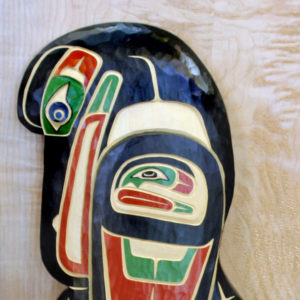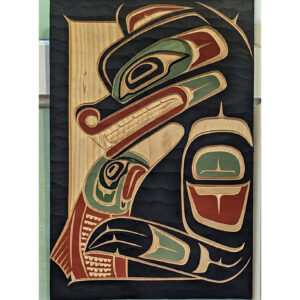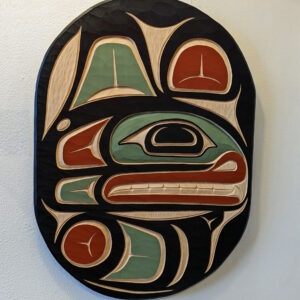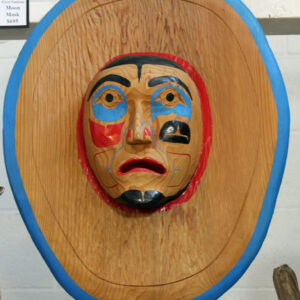Haida First Nation Desktop Paddles
Wonderful 18 inch versions of full size paddles that boast glorious detail and Mother of Pearl inlays. Each has its own cradle to rest in. They also can be wall mounted using the same cradle. Fantastic gift idea! Each one is handcrafted and totally unique, and features it’s own design. All are signed and titled by the artist, priced at $295 each.
The artist is a Haida tribal member who now resides and carves in Port Townsend, WA. If is a member of the Eagle Frog family and was born in Juneau, AK. He is self taught in native formline design and woodcarving. His work ranges from small pieces like these up to large scale wall murals with intricate and beautifully carved details. He has been commissioned by Native entities such as the Goldbelt Corporation, Shee Atika Corporation, and the Southeast Alaska Health Consortium, the State of Alaska, the National Park Service, and others, all who demand authenticity for these commissions.
Haida Gwaii, also known as the Queen Charlotte Islands, is an archipelago off British Columbia’s west coast, in Canada. Wildlife-rich Gwaii Haanas National Park Reserve and Haida Heritage Site includes remote islands and temperate rainforest. Centuries-old totem poles stand in the remains of the Haida Nation village known as SGang Gwaay Llnagaay.
The village of Ninstints (Nans Dins) is located on a small island off the west coast of Haida Gwaii. Remains of houses, together with carved mortuary and memorial poles, illustrate the Haida people’s art and way of life. The site commemorates the living culture of the Haida people and their relationship to the land and sea, and offers a visual key to their oral traditions.
On the island of SG̱ang Gwaay, the remains of large cedar long houses, together with a number of carved mortuary and memorial poles at the village of SG̱ang Gwaay Llnagaay (formerly Nan Sdins), illustrate the art and way of life of the Haida. The property commemorates the living culture of the Haidaand their relationship with the land and sea. It also offers a visual key to their oral traditions. The village of SG̱ang Gwaay was occupied until shortly after 1880. What survives is unique in the world, a 19th-century Haida village where the ruins of houses and memorial or mortuary poles illustrate the power and artistry of Haida society.
SG̱ang Gwaay bears unique testimony to the culture of the Haida. The art represented by the carved poles at SG̱ang Gwaay Llnagaay (Nan Sdins) is recognized to be among the finest examples of its type in the world.
For more: https://whc.unesco.org/en/list/157/







